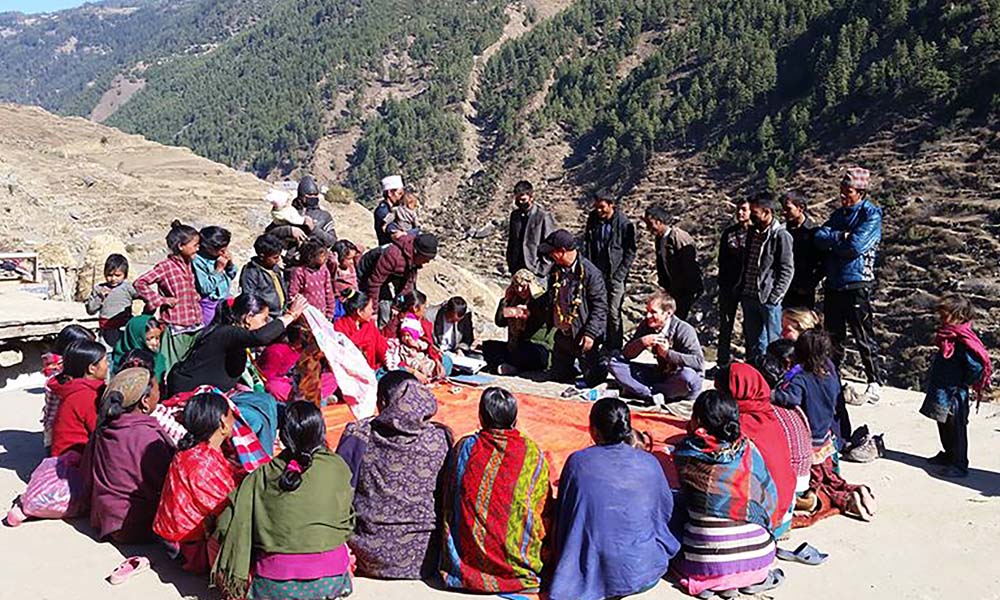INF ambassador Naomi Reed shares personal stories of lives changed in the remote district of Jumla through INF’s Self-Help Group model. Naomi visited Jumla last month and met with communities working together for a better future.
I’d heard about INF’s community health program in Jumla, and I’d seen photos of the work, including the women’s self-help groups… but I found it hard to visualise. I’d never been to visit. And to be honest, being a physio can mean that conceptualising anything beyond primary health care, is actually quite hard. What do they do, day to day? So we went to Jumla, to have a look. And now, writing this, I think that every jolt on that 28-hour jeep journey (from Pokhara to Nepalgunj to Jumla), and every cold wash in the blue bucket – on Jumla’s icy mornings… was absolutely worth it.
The town of Jumla is in west Nepal, and it was late evening when we arrived – dark and very cold. Fortunately, there was dal bhat for dinner, with Jumla’s famous red rice. And the next morning, we got back in the jeep and visited the first self-help group in the village of Kalikakhetu, 20 kilometres further on from Jumla. The wind was blowing down the valley, and we walked up a hill, past a group of small stone houses with flat rooves, and piles of hay, ready for winter. As we walked up the hill, one of the INF staff explained to us that the community included 2,500 people and prior to INF’s involvement, very few of the women could read or write. There were also problems with drinking water, irrigation and rubbish removal. And child marriage was common, and menstruating women were put in the goat yard.
We kept climbing, and found ourselves on another flat roof, where suddenly all the women from the village were gathered in front of us, sitting cross-legged on a red tarpaulin, overlooking the valley. They had formed a self-help group two and a half years ago, facilitated by INF staff, and this was their monthly meeting. They were excited that we’d come! The woman greeted us lavishly, and then they began their official business by asking each other the news. Two women said that it was getting cold, and they needed more firewood. All the others agreed with them about the weather, and so did we! At that point, two other women arrived late, so they danced in front of everyone, and the group clapped and laughed, clearly enjoying themselves. Then they reviewed the actions of the previous meeting, which were to do with waste removal. Another action plan was prepared, and carefully documented. Afterwards, we were able to ask them about the changes they’d seen. They all smiled. “We have learnt to speak!” one of the women said, immediately. “We used to be shy, and we didn’t care about hygiene and sanitation for the whole community – we only cared about our own bodies, if we were sick. But now we care about the whole village, and we solve our own problems together, like water.” Everyone agreed. “The INF workers help us! And now, we can all write our own names. Before, we were using thumb prints. And we are closer to each other. Our husbands are happy, and they bought us each a new dress – matching green skirts and red blouses!”
I wish you could have seen their matching dresses, and the way their faces shone as they talked, and the look in their eyes when they described being listened to, and able to speak, for the first time. The lady sitting next to me introduced herself and said that her son was now the pastor of the small church in the village. They were previously all Hindus.
Change is slow, I wrote in my journal later, and it’s not always easily measurable, but it begins with valuing each life, and letting each person speak, and then working together, as a community. It’s not primary health care, but it’s the long story that continues before, and well after that. And what do the women do now, day to day? Well, they collect water from a tap nearby, and their children go to school, and they write their own names… and their eyes shine when they speak.



